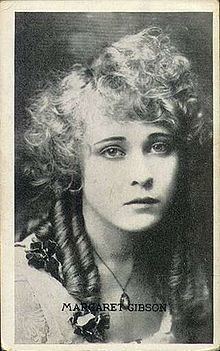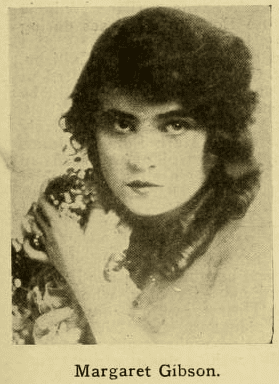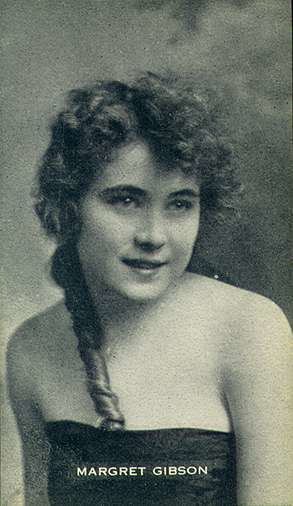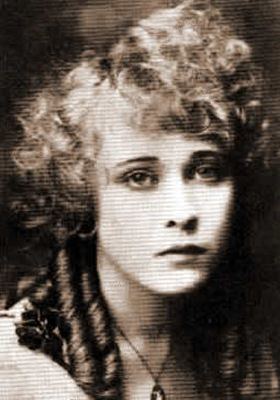Cause of death Heart attack Spouse Elbert Lewis (m. ?–1942) Role Film actress | Name Margaret Gibson Years active 1913-1929 | |
 | ||
Full Name Ella Margaret Gibson Other names Margaret GibsonMargie GibsonMarguerite GibsonHelen GibsonPatricia PalmerPatsy PalmerElla Margaret ArcePat Lewis Died October 21, 1964, Hollywood, California, United States Movies The Kiss, The Coward, The Money Corral Similar People William Desmond Taylor, Cecil B DeMille, Thomas H Ince, William S Hart, Wesley Ruggles | ||
Ella Margaret Gibson (September 14, 1894 – October 21, 1964) was an American stage and silent film actress who had leading roles in Vitagraph westerns, often opposite William Clifford. She also appeared with Charles Ray in The Coward (1915) and later worked in two Westerns with William S. Hart: The Money Corral and Sand!. In 1999 it was reported that on the afternoon of October 21, 1964 she made a dying confession to the murder of director William Desmond Taylor.
Contents
- Career
- 1923 arrest
- Marriage and later life
- Confession and death
- Filmography
- As Marguerite Gibson
- As Margie Gibson
- As Helen Gibson
- As Patsy Palmer
- Uncredited
- References

Gibson was sometimes credited or otherwise identified under at least seven other names, such as Patsy Palmer, Margie Gibson, Marguerite Gibson, Ella Margaret Lewis, Ella Margaret Arce or Pat Lewis. She appeared in 147 movies between 1913 and 1929.

Career

By her own account Gibson's parents had worked in show business. She began her stage career at the age of 12, apparently when her father left and she remained as the sole means of support for her mother. Gibson appeared on the Pantages Vaudeville Circuit for over two years. In 1909 she became a member of the Theodore Lorch Stock Company in Denver where she was cast in a wide variety of roles. She entered the film industry in 1912, getting a job with Vitagraph in Santa Monica where she stayed for three years. For six months during this period Taylor was acting in the same studio and they made four films together: The Love of Tokiwa, The Riders of Petersham, The Kiss and A Little Madonna. An article in Variety magazine the following year noted that the 19-year-old budding film star had purchased a cliffside bungalow overlooking the Pacific Ocean in Santa Monica. In 1915 she left Vitagraph and went to the Thomas Ince Film Company where she played a small supporting role in The Coward, the film which made Charles Ray a star. She subsequently had supporting roles in many comedy shorts and was the subject of several promotional articles in fan magazines.
Her first starring role after Vitagraph was in Mutual Masterpicture's The Soul's Cycle (1916) in which she played both an attractive Roman maiden and a modern New York heiress. Other noted roles included leads in The Riders of Petersham, Back to Eden and The Outlaw.
In 1917 Gibson was arrested for vagrancy under circumstances which included allegations of drug (opium) dealing. After a "largely attended" public trial the popular actress, who "during intermissions... was the center of a bevy of young women," was acquitted but the publicity forced her to quietly change her screen name to Patricia Palmer (among other names). She continued to work in movies but had few leading roles. Gibson obtained many bit parts including a brief appearance in King of Kings.
1923 arrest
On November 2, 1923 (21 months after Taylor's murder) Gibson was arrested at her home at 2324 North Beachwood Drive, Los Angeles, California on federal felony charges involving an alleged nationwide blackmail and extortion ring. She was subsequently charged with extortion and violation of Section 145 of the Federal Criminal Code. George W. Lasher told authorities he had paid Gibson $1155 to avoid prosecution for a reputed violation of the Mann Act. Gibson was also said to be connected to two convicted blackmailers who had pleaded guilty the preceding week to extorting $10,000 from Ohio banker John L. Bushnell. Amid all the publicity following her arrest she was mentioned as both Margaret Gibson and Patricia Palmer. The charges were later dropped by the district attorney's office. Over the next six years she worked sporadically in bit parts and minor supporting roles but the industry's transition to sound film saw the end of Gibson's already thwarted career.
Marriage and later life
In 1935, for unknown reasons, she "fled" to Singapore where she married Elbert Lewis, an auditor for Socony-Vacuum Oil Company (later merged with Mobil Oil). How they met is unknown. From the available documentation, the assumption would be they met on the dock when she arrived in Singapore. However, in a letter to her dated February 8, 1942, Elbert wrote, "Do you remember, dearest, the morning of your first arrival in Singapore, seven sweet years ago, when I pushed all the boats out of the harbor so your ship could come in?" which could be either romantic metaphor, or a hint he was waiting for her there (the same letter mentions a clearly metaphorical female character he calls "Elfin," to which Elbert attributes much "good luck" he apparently thinks they had in the past).
Surviving letters indicate the marriage was stable and she had no intention of ever returning to the United States. The middle-aged couple discussed retiring in either South Africa or Australia. Meanwhile, they moved about constantly in the Bay of Bengal area in the Indian Ocean, staying in Ceylon, India, Burma, Straits Settlements, and Java. In 1940, at the age of 45, Gibson was stricken by a bladder infection, medical treatment for which was not available in the region. With Europe overwhelmed by war and passage to South Africa and Australia threatened by German naval operations, she reluctantly returned without her spouse to Los Angeles and underwent surgery twice at Hollywood Hospital. Her husband Elbert Lewis died when the Japanese bombed Socony-Vacuum's oil facility at Penang, Straits Settlements (now Malaysia) on March 15, 1942.
In 1949, Gibson moved to a small, sparsely furnished house in the Hollywood Hills near Beachwood Village, very close to where she had owned residential property during the 1920s. Living very modestly on a widow's pension under the name Pat Lewis, she reportedly almost never left the house (which was behind thick vegetation), limited her activities mostly to gardening, had a dark grey cat named "Rajah" and even had her groceries delivered.
Confession and death
According to an account first published in 1999 by the widely cited newsletter Taylorology, on October 21, 1964, while still living in Hollywood, Gibson suffered a heart attack. Sensing that she was dying, a highly distraught Gibson—a recently converted Roman Catholic—asked for a priest and then confessed to neighbors the February 1, 1922 murder of Hollywood film director William Desmond Taylor. She may have made statements about a motive but in 1999, the only surviving witness to this incident wrote that at the time, he was young, distracted by the immediate crisis of her heart attack, had no knowledge of who William Desmond Taylor was or what she was talking about. As a result, he could not remember many further details about what Gibson said as she lay dying on the kitchen floor of her small house. The witness did recall Gibson also said she had been "nearly caught" and had "fled the country".
Gibson had apparently made similar remarks once before during the early 1960s. While watching a local television program, Ralph Story's Los Angeles, which featured a short segment about the unsolved murder of Taylor 40 years earlier, Gibson "became hysterical and blurted out that she'd killed him and thought it was long forgotten".
In the aftermath of Taylor's murder newspapers had speculated wildly about possible suspects, and rumors circulated that his death was related to a blackmail attempt. Taylor's neighbor Faith MacLean likely saw the murderer leaving Taylor's bungalow, and said the person she made eye contact with (and who smiled at her) may have been a woman dressed as a man, in clothes which were "like my idea of a motion picture burglar".
During the spring and summer seasons of 1910 Gibson worked as a stage performer in Denver, Colorado at a vaudeville theater owned by Alex Pantages. That same June, Taylor also worked as an actor nearby on the same street at the Tabor Grand Theater. By the age of 18, she had appeared opposite William Desmond Taylor in four films for Vitagraph, including The Kiss. Gibson and Taylor both left Vitagraph in 1915 (Taylor was fired for unknown reasons).
Gibson was in Los Angeles at the time of the murder, but her name was never mentioned during the investigation and no surviving documentation refers to any association between her and Taylor after 1914. Soon after the murder, however, Gibson (using the name Patricia Palmer) got work in a number of films produced by Paramount-Lasky, Taylor's studio at the time of his death. Moreover, one of these films was among the last made by Mary Miles Minter, with whom Taylor had been (allegedly) involved romantically.
Gibson's reported confession does not conflict with the known historical record. Given her documented arrest record along with Taylor's reportedly odd remarks in the weeks leading to his murder, the inferred motive would have been somehow related to blackmail in the wake of the Roscoe Arbuckle scandal, during which the private lives of most Hollywood celebrities could easily fall under highly sensationalized public scrutiny (the evening after Taylor's body was found, the Los Angeles Evening Herald carried news of Taylor's murder as a banner headline with an article about the ongoing Arbuckle trial immediately below).
All of the police files and physical evidence relating to Taylor's murder had disappeared by 1940, and aside from circumstantial evidence, no independent confirmation of Gibson's involvement in it has since emerged. Margaret Gibson is buried at Holy Cross Cemetery in Culver City, California.
Filmography
Throughout her career Gibson's many movie appearances were credited under at least six different names. However, overwhelmingly she was credited under only two, first as Margaret Gibson and later as Patricia Palmer.
